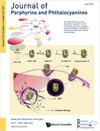Interfacial nanoarchitectonics with porphyrins and related molecules: Langmuir-Blodgett method and layer-by-layer assembly
IF 0.9
4区 化学
Q4 CHEMISTRY, MULTIDISCIPLINARY
引用次数: 1
Abstract
Nanoarchitectonics is the methodology for the architecture of nano-units of atoms, molecules, and nanomaterials to create functional material systems. This will integrate nanotechnology with other fields such as organic chemistry, supramolecular chemistry, material science, microfabrication technology, and bio-related sciences. Through this review, it is shown that nanoarchitectonics is important for the development of various functional materials. Porphyrins and their analogues are exemplified as important players in nanoarchitectonics strategies. The contents of this review can be briefly summarized as follows. First, recent examples of studies on porphyrins and their analogues, ranging from organic synthesis as basic research to biomedical applications as advanced usages, are presented. This demonstrates the broad utility of porphyrins as functional nano-units, from molecular nanoarchitectonics to material nanoarchitectonics. In subsequent sections, the organization and function of porphyrin assemblies by the Langmuir-Blodgett (LB) method and layer-by-layer (LbL) assembly are described as examples of nanoarchitectonics at interfaces. The creation of functional materials through nanoarchitectonics is rich in possibilities. Conversely, the wide range of possibilities may make it difficult to easily design and control. Confine the system from free three-dimensional space to a two-dimensional field such as an interface, and design, creation, and evaluation may become easier. The nanoarchitectonics of functional structures in a two-dimensional plane are also advantageous in terms of functional expression. The use of interfacial environments is an extremely powerful tool for creating functional systems through nanoarchitectonics.卟啉及其相关分子的界面纳米结构:Langmuir-Blodgett方法和逐层组装
纳米建筑学是原子、分子和纳米材料的纳米单元结构的方法论,用于创建功能材料系统。这将整合纳米技术与其他领域,如有机化学、超分子化学、材料科学、微制造技术和生物相关科学。本文综述了纳米结构学在各种功能材料开发中的重要作用。卟啉及其类似物在纳米结构策略中发挥着重要作用。本文综述的内容可以简单概括如下。首先,介绍了卟啉及其类似物的最新研究实例,从作为基础研究的有机合成到作为高级用途的生物医学应用。这证明了卟啉作为功能纳米单位的广泛用途,从分子纳米结构到材料纳米结构。在随后的章节中,通过Langmuir-Blodgett (LB)方法和逐层(LbL)组装的卟啉组装的组织和功能被描述为界面纳米结构的例子。通过纳米建筑学创造功能材料具有丰富的可能性。相反,广泛的可能性可能使设计和控制变得困难。将系统从自由的三维空间限制到界面等二维领域,设计、创建和评估可能会变得更容易。功能结构在二维平面上的纳米结构在功能表达方面也具有优势。使用界面环境是通过纳米架构创建功能系统的一个非常强大的工具。
本文章由计算机程序翻译,如有差异,请以英文原文为准。
求助全文
约1分钟内获得全文
求助全文
来源期刊
CiteScore
2.10
自引率
20.00%
发文量
62
审稿时长
1 months
期刊介绍:
The Journal of Porphyrins and Phthalocyanines (JPP) covers research in the chemistry, physics, biology and technology of porphyrins, phthalocyanines and related macrocycles. Research papers, review articles and short communications deal with the synthesis, spectroscopy, processing and applications of these compounds.

 求助内容:
求助内容: 应助结果提醒方式:
应助结果提醒方式:


